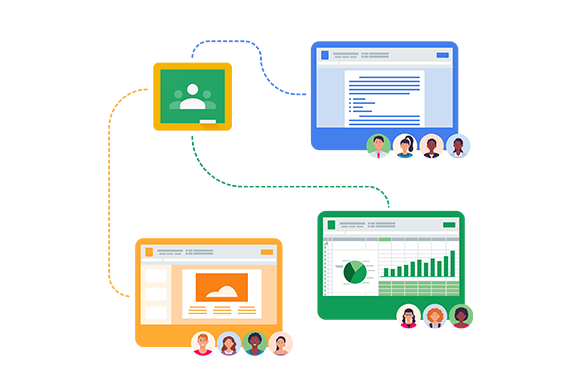
By teacher guest blogger Kathryn Rose
The pandemic has left the average human with some amazing, and completely unasked for – new life skills. For example, some of us know how to perfectly adjust masks to keep them from fogging reading glasses. We can also accurately estimate a six-foot distance and know which brands of soap kill the most viruses on hard surfaces. These skills, of course, extend to the technological and likewise, edtech. Read on to learn about how Google Classrooms came out on top – and is evolving to better meet the needs of educators.
Anyone and everyone who tried to juggle their “normal” life during the height of the pandemic intuitively knows that our dependence on various technologies increased rapidly over a short period of time. Entire companies tried to move their operations onto Slack channels and Zoom meetings. Hospitals built infrastructure for virtual care and visits.
And schools?
Teachers had to make the seemingly impossible happen – they had to recreate a classroom environment completely online.
As we all watch hopefully for the pandemic to sputter to its tragic end, we need to come to terms with a world that has been permanently changed by how these different technologies have been woven into the fabric of our daily lives. The exciting news is that, with two years under our belt, there’s an incredible amount of data driving this understanding and change.
According to a new analysis by App Annie, mobile education apps experienced a 90% increase in weekly downloads worldwide during the first few months of the pandemic. The overall growth rate in the United States was a staggering 135% and was surpassed by countries like Australia, the UK, and Brazil, which had rates of up to 190%.
In American classrooms the apps that have seen the most growth included Google Classroom, Remind: Safe Classroom Communication, and ClassDoJo. Google Classroom even came out on top of overall download lists competing with apps like Zoom and TikTok.
Using data collected and analyzed over the past year, Google Classroom has started to respond to the challenges and changes of the virtual classroom. Most notably, Google analysts have noticed that teachers are using their virtual platform as a complete hub, or learning management system (LMS), for their schools and classrooms.
The rub is: Google didn’t set out to create a learning management system. Now, they’re rapidly trying to respond to the ways in which their platform is actually being used by their end consumers. Armed with an overwhelming amount of data and a league of developers, Google is setting out to make the impossible task for teachers a little more… possible!
Here are a few new developments that Google is working hard to integrate into their application:
If you are an administrator:
• You will be able to access deeper insights into classroom management behaviors through audit logs. Audit logs will be available through the Admin Console and will help principals pinpoint instigating events that will keep them on top of parent and teacher communication.
• You will be able to integrate your Google audit logs to applications such as Education Standard or Education Plus which will help you analyze weekly and monthly data points.
If you are a teacher:
• You will be able to set up your classes in advance with SIS roster syncing.
• You will be able to streamline your grade entry with Grade Export. This will allow teachers to track grades and push them from the gradebook to the SIS which should eliminate the need to record the data in two places.
• You will be able to utilize your mobile device with greater ease - allowing you to switch between student assignments and the gradebook with ease.
• You will be able to check your student’s work for plagiarism using Originality reports.
• You will be able to use rich text formatting to customize Classroom assignments.
If you are a student:
• You will be able to work on your assignments offline or with intermittent connections.
• You will be able to start, review assignments, open Drive attachments, and write assignments in Google Docs without WiFi.
• You will be able to submit clear pictures of your homework for your teachers to review.
Education technology will continue to evolve long after the pandemic is in the rearview mirror. In many ways, companies like Google are setting new standards in edtech that are likely to be used for years to come.
For more detailed information on Google’s new and improved mission for Google Classroom, you can look through their article here.
------------------------------------------
About Kathryn Rose
Kathryn Rose is currently a virtual tutor and a museum resource teacher. She also freelances for businesses and startups in the education field. She has taught at her city’s botanic garden for 12 years and has been a Social Studies teacher in both private and public schools.


